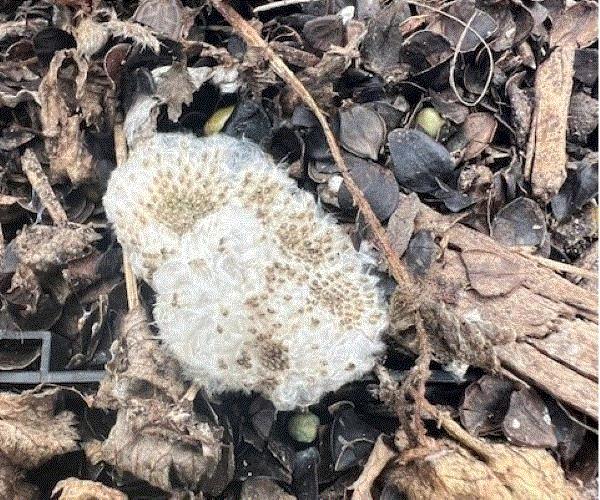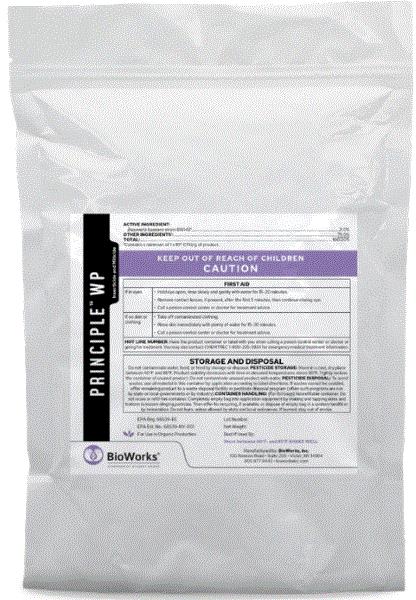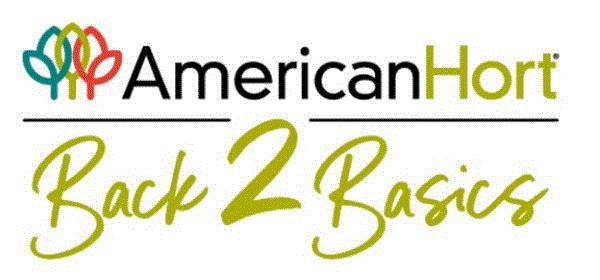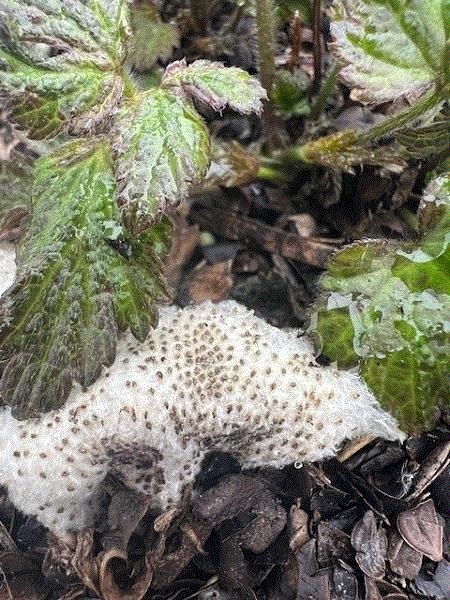What the ... ?
Chris Howe of Hortech provided a stumper for me a couple of weeks ago. It’s puffy, soft and light, which makes it look like a cotton ball or a piece of blown insulation fallen off from somewhere.
What in the world is this?

New Principle WP Bioinsecticide
BioWorks announced last week that the EPA approved the registration of its new Principle WP bioinsecticide. State registrations are pending; products will be available as soon as state registrations are granted.
Principle WP contains the entomopathogenic fungus Beauveria bassiana. Y’all probably remember that BioWorks used to carry BotaniGard (now carried by OHP), which is also a Beauveria bassiana strain GHA formulation. Principle WP contains a different strain of Beauveria bassiana, called BW149.

Several key features of Principle WP include wettable powder formulation (which has a better crop safety profile), four-hour restricted entry interval (REI), zero-day pre-harvest interval (PHI) and is OMRI listed. Personal protective equipment (PPE) includes long-sleeved shirts and long pants, waterproof gloves, shoes plus socks, and protective eyewear for applicators and handlers. Coveralls are an additional PPE for early entry workers.
Principle WP has a very broad spectrum of use sites. It can be used on food crops and non-food crops (including ornamentals) indoor and outdoor. It also has a very broad spectrum of target pests, with thrips, whiteflies, aphids, mealybugs and caterpillars being some of the major targets. Application rates are between 0.5 to 2 lb. per 100 gal. depending on pest species and application methods. Principle WP can be applied by spray, drench or cutting dip.
This product is stable at room temperature for 12 months. Refrigeration is not needed, which makes storage a bit easier. Principle WP is safe to crops, leaves minimal residue, and compatible with many conventional and biopesticides.
Go HERE to find more information about Principle WP, including label, SDS, trial data, overviews, guidelines on low volume application and more. Go HERE for a technical white paper on Principle WP, where you’ll find lots of useful technical details, such as the speed of activity, optimal temperature and relative humidity, application rates and frequencies, trial data, etc.

A New Use of Anti-Transpirant?
The paper title, “Evaluation of fungicides, host-plant defense inducer and anti-transpirant in management of boxwood blight,” by Bhawana Ghimire and her colleagues has me scratching my head.
I know an anti-transpirant isn’t the same as anti-perspirant for arm pits (and apparently for everywhere else on the body of some super odor-conscious folks). Anti-transpirant can help reduce plant water demand by closing the stomata, changing the metabolic rate or forming a film that reflects sunlight or slows down water loss.
There are several anti-transpirants in the market, but I never really know what anti-transpirants have to do with disease management. Apparently, by forming a film, anti-transpirants can interfere with the attachment of fungal spores to leaf surfaces, spore germination or germ tube growth, thereby affecting infection. Some may have direct toxicity on fungi. The effects of anti-transpirants on some diseases, such as Botrytis and downy mildew, have been documented.
Bhawana and her colleagues conducted a series of experiments to see if preventive-curation rotations consist of various combinations of three fungicides (chlorothalonil or Daconil Weatherstik; flutriafol or F6123-1; pydiflumetofen + difenoconazole or Postiva), one disinfectant (quaternary ammonium chloride or KleenGrow), one plant defense inducer (acibenzolar-S-methyl or Actigard), and one anti-transpirant (di-1-p-menthene or Vapor Gard) can help improve management of boxwood blight. The treatments were compared to inoculated control and non-inoculated control.
I couldn’t get my head out of the anti-transpirant idea, so I focused my attention on this aspect when reading this rather complicated paper. What’s interesting to me is that preventive applications of Actigard alternated with Vapor Gard reduced disease severity, progression and defoliation. Rotation of Vapor Gard with other fungicides also achieved good suppression of the disease.
Now, what about the other two dozen treatments also evaluated in this study? Bhawana and her team found that all treatment combinations reduced disease progression and severity compared to the inoculated control. Happy day! Preventive and curative treatments of Postiva alternated with Vapor Gard seems to have the highest efficacy in my reading of the data. This rotation is something new in managing foliar diseases. Preventive and curative treatments with Postiva, Daconil, KleenGrow and their rotations also worked well.
Bhawana completed this project under the direction of Fulya Baysal-Gurel at Tennessee State University’s Otis Floyd Nursery Research Center in McMinnville, Tennessee. The project was supported by a USDA Specialty Crop Research Initiative Grant. The paper was published in Volume 35, issue 1, of HortTechnology. Go HERE to read it.

AmericanHort’s Educational & Certification Opportunities
AmericanHort launched its Greenhouse Technician Certification program in 2023. Recently, it announced the addition of a new certification—the Greenhouse Section Grower Certification—to its education program.
Greenhouse Section Grower Certification is a self-paced training program for growers. It's suitable for technicians looking to advance their career, new growers wanting to build essential skills, and employees seeking to improve performance and workflow.

Participants will go through 15 courses in three modules and learn about substrates, nutrients, pests, diseases, water quality, lighting, crop scheduling, quality control, business operations and other important skills. The lectures are taught by industry experts and are available in video demonstrations, practical applications and assessments.
Go HERE to register for the course or individual modules. Prices vary depending on membership and participating in individual modules or the entire course.
Not wanting to spend time or lots of money on the entire course? You just want to learn about one topic at a time? Well, you can also get an education through AmericanHort’s Back2Basics webinars.

The Back2Basics webinars cover topics such as how to start an IPM program (taught by Drew Jeffers of Clemson University), common diseases (taught by Margery Daughtrey of Cornell Extension) and water quality as it related to ornamental production (taught by Byran Fuhrmann of SePRO Corporation). You can view the webinar you've signed up for at any time during a one-year period.
Go HERE to see what webinars are available and to register. Each webinar costs $39 to $99 for a one-year subscription.

Answer to "What the ... ?"
The “What the …?” mystery picture can be a little weird when it’s placed out of context, i.e. on a bed of media without any plants. Chris also sent me this other picture, which shows some leaves and should have helped me solve the mystery if I’d known my plants a little better.
I figured, “Okay, I’m going to use this in the newsletter, but I better give it another try on identifying this weird stuff.” I still couldn’t get it for weeks. So I called on Janna Beckerman of Envu, who's as knowledgeable about her plants as she is on diseases (and pests, birds, etc.). Well, truthfully, I was hoping for Janna to tell me it’s some super uncommon or weird disease I’d seen for the first time. Her verdict: Anemone seed cluster. That sure made me feel rather … how should I put it ...? Disappointed ...?

So there you have it. It isn’t a piece of insulation, nor a cotton ball or some weird disease. I guess cotton ball may be closer since it’s of plant origin.
I’ve seen anemones in the past. It’s not very common in my South Carolina Coastal Plains, Zone 8b neighborhood, but there are a few here and there. I've never seen them produce seed heads, so this is the first time.




See y'all later!

JC Chong
Technical Development Manager at SePRO
Adjunct Professor at Clemson University
This e-mail received by 27,847 subscribers like you!
If you're interested in advertising on PestTalks contact Kim Brown ASAP!